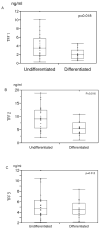Tests for serum levels of trefoil factor family proteins can improve gastric cancer screening
- PMID: 21699780
- PMCID: PMC3163741
- DOI: 10.1053/j.gastro.2011.05.040
Tests for serum levels of trefoil factor family proteins can improve gastric cancer screening
Abstract
Background & aims: Improving methods for early detection of gastric cancer could reduce mortality. Measurements of serum pepsinogen levels have been used for screening in Japan without satisfactory levels of sensitivity or specificity. Trefoil factor family (TFF) proteins (TFF1, TFF2, and TFF3) are small and stable molecules secreted by the mammalian gastrointestinal tract. Foveolar hyperplasia, spasmolytic polypeptide (TFF2)-expressing metaplasia, and intestinal metaplasia are histologic changes observed in patients with atrophic gastritis; they express TFF1, TFF2, and TFF3, respectively. We investigated whether serum levels of TFF can be used as markers for gastric cancer screening.
Methods: Serum was collected from 183 patients with gastric cancer and 280 healthy individuals without cancer. Serum levels of anti-Helicobacter pylori immunoglobulin G, pepsinogen I, pepsinogen II, TFF1, TFF2, and TFF3 were measured by enzyme-linked immunosorbent assay and associated with gastric cancer.
Results: Using a cutoff of 3.6 ng/mL, the level of TFF3 was significantly increased in serum samples from patients with cancer (odds ratio, 18.1; 95% confidence interval, 11.2-29.2); using this test, patients with cancer were identified with 80.9% sensitivity and 81.0% specificity. The test for TFF3 had a significantly higher odds ratio than that for pepsinogen. A test for the combination of TFF3 and pepsinogen had better results than the test for only pepsinogen.
Conclusions: Serum levels of TFF3 are a better marker of gastric cancer than pepsinogen; a test for the combined levels of serum pepsinogen and TFF3 could improve gastric cancer screening.
Copyright © 2011 AGA Institute. Published by Elsevier Inc. All rights reserved.
Conflict of interest statement
Conflict of interest
Yasukazu Ohmoto is an employee of Otsuka Pharmaceutical Company, which is making anti-cancer drugs.
Figures









References
-
- Pisani P, Parkin DM, Bray F, et al. Estimates of the worldwide mortality from 25 cancers in 1990. Int J Cancer. 1999;83:18–29. - PubMed
-
- Hamashima C, Shibuya D, Yamazaki H, et al. The Japanese guidelines for gastric cancer screening. Jpn J Clin Oncol. 2008;38:259–67. - PubMed
-
- Miki K, Ichinose M, Kakei N, et al. The clinical application of the serum pepsinogen I and II levels as a mass screening method for gastric cancer. Adv Exp Med Biol. 1995;362:139–43. - PubMed
-
- Plaut AG. Trefoil peptides in the defense of the gastrointestinal tract. N Engl J Med. 1997;336:506–7. - PubMed
-
- Ribieras S, Tomasetto C, Rio MC. The pS2/TFF1 trefoil factor, from basic research to clinical applications. Biochim Biophys Acta. 1998;1378:F61–77. - PubMed
Publication types
MeSH terms
Substances
Grants and funding
LinkOut - more resources
Full Text Sources
Other Literature Sources
Medical

